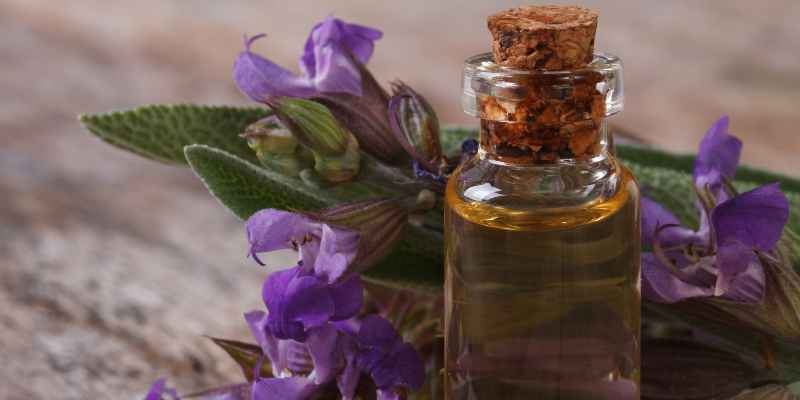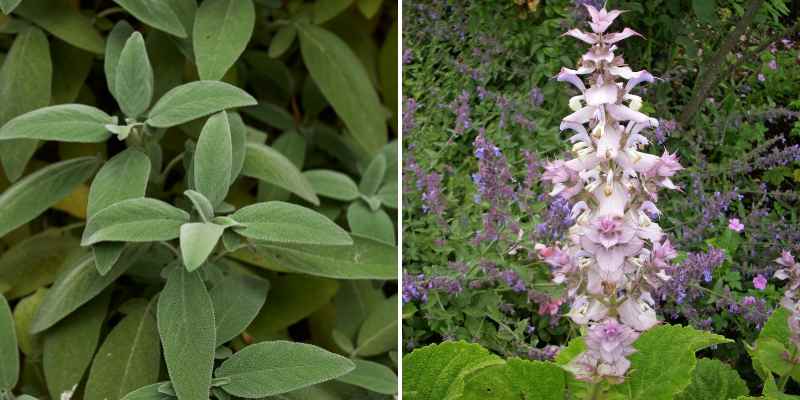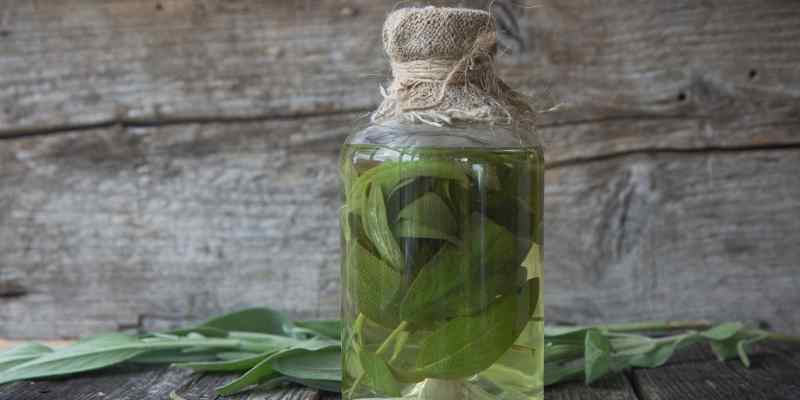Sage oil is a very easy-to-make natural treatment, perfect for enjoying the benefits of this aromatic plant. Known for its many virtues and long used in phytotherapy and natural cosmetics, sage oil is particularly beneficial for the skin, face, and hair.
Do not confuse it with sage essential oil; this preparation is a gentle infusion of sage leaves in a vegetable oil. Milder and simpler to use daily, it is ideal for sensitive skin and natural beauty routines. Thanks to its anti-inflammatory, regulating, and regenerative properties, it hydrates and soothes the skin, purifies the scalp, and restores radiance and suppleness to the face.
Here’s how to easily prepare your homemade sage oil, with our quick and simple tutorial!

Which sage varieties to choose for making sage oil?
The best variety to use for preparing an effective treatment oil is common sage (Salvia officinalis). It is renowned for its soothing, antiseptic, and purifying properties. If you opt for the benefits of clary sage (Salvia sclarea), use the flowering tops (flowers and young stems), as these contain the highest concentration of active compounds, particularly for hormonal or soothing treatments. The leaves of clary sage can also be used, but they are less concentrated in aromatic compounds than the flowers.
Caution! In all cases, avoid ornamental sage varieties, as they do not have the same therapeutic or cosmetic properties. Ensure you choose fresh, organically grown sage to guarantee a healthy oil rich in plant actives.

Which vegetable oil should you choose?
To prepare your homemade sage oil, it is advisable to use a neutral and gentle vegetable oil that preserves the plant’s active compounds while being kind to the skin and hair. Organic extra-virgin olive oil is an excellent choice due to its antioxidant and nourishing properties. You can also opt for sweet almond oil or jojoba oil for their nourishing, hydrating qualities and natural affinity with the skin and hair.

How to make sage oil step by step?
Required materials
- A glass jar with an airtight lid
- A dark glass bottle for storage
- A coffee filter or fine muslin cloth
Ingredients
- Approximately 20 to 30 g of dried sage leaves or 2 to 3 handfuls of fresh sage leaves, lightly air-dried
- 250 to 300 ml of vegetable oil of your choice
Clary sage variation:
- 15 to 20 g of dried flowering tops or 2 handfuls of fresh flowers, lightly air-dried to remove moisture
- 250 to 300 ml of vegetable oil
Cold infusion method
Step 1: Harvesting the leaves
Pick fresh sage leaves or flowers, ideally in the morning when their active compounds are most concentrated.
Step 2: Partial drying
Air-dry the leaves or flowers for a few hours, just enough to remove surface moisture. This prevents mould growth during infusion.

Step 3: Preparing the jar
Place the lightly crushed leaves in a clean, dry glass jar. Do not pack them too tightly to allow the oil to circulate.
Step 4: Adding the vegetable oil
Completely cover the leaves with your chosen vegetable oil. Ensure all leaves are fully submerged.

Step 5: Starting the infusion
Seal the jar tightly and place it in a warm, dark location. Let it infuse for about three to four weeks.
Step 6: Regular agitation
Gently shake the jar once or twice a week to distribute the active compounds evenly in the oil.
Step 7: Filtering
Once the infusion is complete, strain the oil using muslin or a coffee filter to remove all plant particles.
Step 8: Bottling
Pour the filtered oil into a clean, dry dark glass bottle. Store it in a cool, dark place to preserve its qualities.
What are the benefits and virtues of sage oil?
Sage oil has multiple benefits. Thanks to its antibacterial and regulating properties, it helps purify and balance oily or combination skin, while soothing irritation in sensitive or redness-prone skin. For hair, sage oil is known to calm itching, reduce dandruff, and regulate sebum production. It adds softness, shine, and vitality to tired or dull hair. Finally, when applied to the face, it offers anti-ageing benefits by helping to reduce minor imperfections and stimulate skin regeneration.
The oil made from clary sage stands out for its hormone-regulating properties. It is traditionally used to relieve discomfort related to menstrual cycles, premenstrual syndrome, or pre-menopause. It also has a calming and balancing effect on emotions, helping to soothe stress or nervous tension. However, these hormonal properties mean it is contraindicated for certain individuals (see the dedicated section).
How to use sage oil?
Homemade sage oil is for external use only. It should not be used in cooking or consumed, as it is not prepared according to food safety standards. For the face, apply a few drops to clean skin as a night treatment, focusing on oily or blemish-prone areas. It helps purify, balance sebum, and tighten pores.
For hair, it can be used as a pre-shampoo oil treatment. Massage the scalp with the oil to regulate excess sebum, soothe itching, and stimulate circulation. Leave it on for at least 30 minutes before washing with a gentle shampoo. For the body, sage oil can be used in massage, particularly on areas prone to water retention or muscle fatigue. It provides a toning and circulatory effect.
If made with clary sage, the oil can be massaged onto the lower abdomen to support menstrual cycles or pre-menopause, thanks to its hormone-regulating effects. It can also be used as a massage oil or after-sun treatment to calm redness, hydrate, and tone the skin, especially after prolonged sun exposure.
A patch test is always recommended before first use, especially for sensitive skin.
How to store your homemade sage oil?
To preserve your homemade sage oil for longer, always use a dark glass bottle with an airtight seal to protect the oil from light and oxidation. Store it in a cool, dry place away from heat. This way, your oil can retain its properties for about six months to a year, depending on the vegetable oil used. Check its smell and appearance regularly to ensure it has not gone rancid.

Precautions and dangers of sage oil
Sage oil obtained by infusion is much milder than sage essential oil, meaning it is significantly less concentrated in active compounds. Unlike essential oil, it does not contain highly concentrated volatile compounds, making it generally better tolerated for topical use. However, it is not without effects, and certain precautions are necessary. It is not recommended for pregnant or breastfeeding women due to its potential hormonal effects. As a precaution, it should not be used on children under six years old. It should also be avoided by individuals with epilepsy or neurological disorders. Finally, its use is not advised for women with or showing symptoms of hormone-dependent cancers, such as certain breast or uterine cancers. A patch test in the elbow crease is always recommended before first application.
































Comments